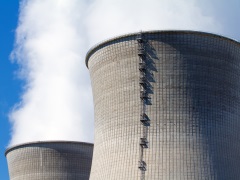Features
Syngas blows hot and cold
Date: 2017-12-21 12:53:18.0
Author: Jon Evans

Capturing the carbon dioxide released from power plants and other major industrial producers before it enters the atmosphere is clearly an effective way to limit global warming. But converting the captured carbon dioxide into something useful, rather than simply storing it, would be even better.
Several research groups have recently come up with ways for doing that. All these ways are very different, but they all involve converting the carbon dioxide into the same useful something: the mixture of carbon monoxide and hydrogen known as syngas. This is because syngas can easily be converted into petroleum-like fuels and a range of industrial chemicals using a mature catalytic process based on the Fischer-Tropsch reaction.
The most obvious way to convert one chemical into another is via a catalyst, and nickel-based catalysts are known to be able to convert a mixture of carbon dioxide and methane into syngas. If the carbon dioxide comes from industrial processes and the methane comes from natural gas, then then this offers an efficient way to produce fuels and chemicals. Although it can still result in carbon dioxide being released into the atmosphere, the rate is lower, as the same resources are essentially being used twice: to power the industrial process and then to produce a fuel. At best, if the carbon dioxide is captured directly from the atmosphere, the process could be almost carbon neutral.
The problem is that converting a mixture of carbon dioxide and methane to syngas at the necessary high temperatures generates a lot of waste coke, which tends to coat the catalyst and prevent it from working. So a team of scientists from the UK and Spain, led by Tomas Reina at the University of Surrey, decided to try developing a catalyst that didn’t suffer from this problem. To do this, they added tiny amounts of tin to the nickel catalyst, and also added ceria (CeO2) to the alumina (Al2O3) support that houses the nickel catalyst.
The tin helps to slow coke formation, while the ceria helps to oxidize any solid coke that does form, turning it back into carbon dioxide. As the scientists report in Applied Catalysis B: Environmental, this allowed their catalyst to stay active for an impressive 92 hours.
Natural gas is also an essential ingredient of another new process for producing syngas from carbon dioxide. Rather than a catalyst, however, this process utilizes a perovskite membrane. Perovskites are a family of minerals comprising various different elements in the same crystal structure. Xiao-Yu Wu and Ahmed Ghoniem from Massachusetts Institute of Technology in the US developed a perovskite membrane comprising calcium, lanthanum and iron oxide.
As they report in ChemSusChem, this membrane could strip oxygen atoms from a stream of carbon dioxide flowing on one side, converting it to carbon monoxide. To ensure a steady flow of oxygen atoms through the membrane, Wu and Ghoniem pass a stream of methane on the other side, which reacts with the oxygen to produce carbon monoxide and hydrogen. This can then be combined with the carbon monoxide from the other side to produce syngas.
Even though this process requires high temperatures, of 990°C, it doesn’t suffer from the coke formation problems that bedevil catalyst-based processes, able to produce syngas at the same rate for over 100 hours. But high temperatures always add expense, even if much of the heat can be derived from the same industrial processes that produce the carbon dioxide.
That isn’t a problem for the process developed by scientists at Idaho National Laboratory in the US. By capturing the carbon dioxide in a solvent, this process can produce syngas at room temperature. As the scientists report in Green Chemistry, the carbon dioxide is captured as a bicarbonate in a switchable polarity solvent, which switches polarity on exposure to specific chemical compounds.
The switchable polarity solvent is then introduced to one side of an electrochemical cell, with water on the other side, separated by a proton-exchange membrane. Applying electricity to the cell causes the water to split into oxygen and hydrogen ions (protons), which pass through the membrane to react with the bicarbonate in the solvent, releasing the carbon dioxide. This is then electrochemically reduced to carbon monoxide, which combines with the hydrogen to produce syngas, all at a temperature of just 25°C.
The views represented here are solely those of the author and do not necessarily represent those of John Wiley and Sons, Ltd. or of the SCI.
Displaying 11 keywords used to tag this article:
- Omega Museum Classic Watches
- Christian Louboutin Hommes
- Roger Vivier Belle De Nuit Bicolor
- Omega Black 2594.52.00 Seamaster Wa
- Heritage Collection - Heritage - Ho
- Omega Constellation - Men's : repli
- Replica Great Omega Hour Vision See
- omega speedmaster
- Replica Omega Watches-Constellation
- Michael Kors Wallet iPhone 6 Plus C
- Top Kwaliteit baljurk trouwjurken
